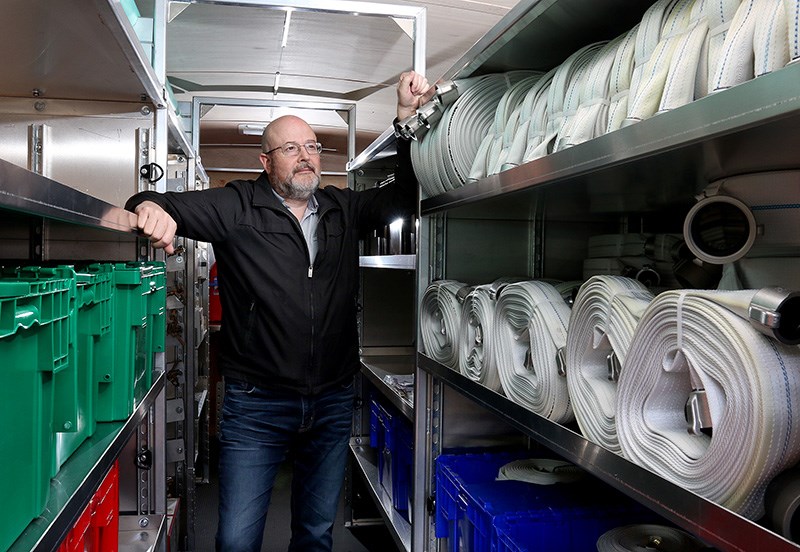Climate change might be bad for Randy Cowling’s grandchildren. But it’s good for his business.
Cowling’s company, WASP Manufacturing, is launching production of its new wildfire protection trailer at its Port Moody facility on Spring Street.
The 8,000-pound trailers are equipped with storage racks and bins that contain everything needed by crews fighting wildfires in remote and interface areas to protect structures and suppress the flames to where they can be managed. That equipment includes up to 7,000 metres of hose, heavy-duty pumps, sprinklers, valves, and splitters, as well as a chainsaw and toolkits for repairs and modifications along the way.
Cowling said the trailers are small enough to be attached to a half-tonne pickup truck that doesn’t require a special driver’s license and can be maneuvered in and out of the bush and along backroads and trails quickly. Once on the scene of a wildfire, crews can deploy the hoses and sprinklers to dampen the area around a blaze so it doesn’t alight. Water can be pumped from a nearby lake or stream, or from one of the giant orange bladders in the trailer that can hold up to 3,000 gallons.
Cowling said speed and maneuverability are key to fighting wildfires and limiting the damage they can cause.
“You have to get it out there as quickly and easily as possible,” he said, adding the equipment can also be used to pump away water from floods.
And the need to deploy such specialized equipment is growing as the effects of climate change take hold. Summers are getting drier and winter and spring rainy seasons are getting wetter. Average rainfall in summer is expected to drop 19% by 2050, while the average precipitation in Metro Vancouver is forecast to increase 5% in the same time period. In the past two wildfire seasons, more than 21,000 square kilometres have burned in B.C.
“You can’t argue there’s not climate change,” said Cowling, whose company also manufactures rooftop sprinkling systems to protect homes from burning embers.
Cowling said his company is producing 10 of the $120,000 trailers that will be used by BC Wildfire Services and by fire departments as far away the Northwest Territories and Ontario. The trailers are designed to meet specifications in other provinces like Alberta, Saskatchewan and Manitoba as well. They’re also equipped to be tracked by satellite should one go missing.
One of the trailers has been acquired by the Richmond fire department, which had to get help from other Metro Vancouver fire departments that already own such a trailer, like Port Moody, when it had to fight a stubborn wildfire in a forested bog near Westminster Highway and Shell Road last summer.
Cowling said his company pre-builds most of the trailers’ interior components, like the custom racks and shelving, so it can turn around construction and equipping in about 30 days.
But with the threat of wildfires seemingly increasing with every summer heatwave, getting that turnaround time even shorter could soon be a necessity that is hindered by the availability of equipment like hoses, which needs to be ordered months in advance, Cowling said.
“It does make you nervous,” he said of the growing demand for his product.
— with a file from Gary McKenna



